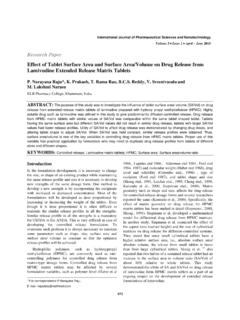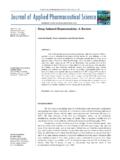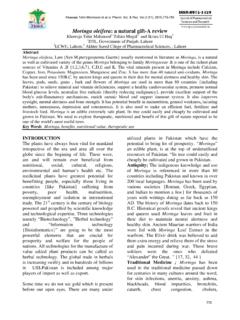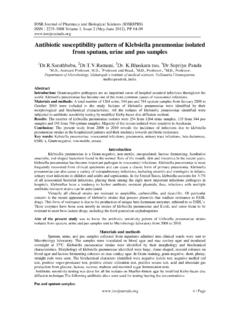Transcription of Int J Pharm Sci Nanotech Vol 8; Issue 2 International ...
1 2828 Int J Pharm Sci Nanotech Vol 8; Issue 2 April June 2015 Research Paper Simultaneous Determination of Dextromethorphan and Pro-methazine in Pharmaceutical Syrups by Rapid HPLC Method SalehTrefi Department of Quality Control and Pharmaceutical Chemistry, Faculty of Pharmacy, University of Aleppo, Aleppo, Syrian Arab Republic. Received November 11, 2014; accepted January 3, 2015 ABSTRACT A simple, precise and accurate method is validated for the simultaneous determination of two nitrogenous compounds dextromethorphan hydrobromide and promethazine hydro-chloride, which are commonly used as active ingredients in pharmaceutical syrups. The chromatographic conditions comprised of a classical C8-type stationary phase (250 mm, 5 m) with a mobile phase consisting of 3 g of sodium lauryl sulfatein a mixture of 400 ml of water and 600 ml of acetonitrile along with g of ammonium nitrate as additional agent.
2 The solution pH was adjusted with glacial acetic acid. The flow rate was 1 ml/min; the detection was carried out at 280 nm under temperature of 25o. The retention time of dextromethorphan was min and min for promethazine. The method was validated for specificity, accuracy, precision and linearity. The results indicate that the drugs are susceptible to photo-degradation. All the peaks of degraded products were resolved from the two active pharmaceutical ingredients with significant different retention times. KEYWORDS: Dextromethorphan; Promethazine; Syrups; assay validation. Introduction Dextromethorphan (ent-3-methoxy-17-methylmor-phinan hydrobromide monohydrate) is an opioid receptor agonist used as cough suppressant Fig. 1. Literature survey revealed that the recommended analytical method of dextromethorphan and its related substances was mentioned in the British Pharmacopeia (British Pharmacopeia, 2013).
3 Many other analytical methods of dextromethorphan alone or with combination with other drugs in pharmaceutical dosage forms were reported in previous researches such as HPLC methods (Al-Rimawi, 2010; Tedesco et al., 2013; Rauha et al., 1996; Wilson et al., 1993; Louhaichi et al., 2009). Hydrophilic interaction liquid chromatographic procedure for the simultaneous determination of pseudoephedrine hydrochloride, diphenhydramine hydrochloride and dextromethorphan hydrobromide in cough-cold formulations was also reported (Shahid et al., 2007). Fig. 1. Chemical structure of dextromethorphan. Carbon paste and PVC electrodes for the flow injection potentiometric determination of dextromethor-phan was conducted by Elmorsy et al, 2010. A micellar electrokinetic capillary chromatography and capillary zone electrophoresis was investigated for simultaneous determination of dextromethorphan, diphenhydramine and phenylephrine in expectorant and decongestant syrups (Gomez et al.)
4 , 2002). UV methods for the determination of dextromethorphan HBr has been reported (Tantishaiyakul et al., 1998; Tan et al., 1998). Promethazine (2RS)-N,N-Dimethyl-1-(10H-phenothia-zin- 10-yl)propan-2-amine hydrochloride is a histamine H1 receptor antagonist Fig. 2. The recommended analytical method of promethazine and its related substances was reported in the British Pharmacopeia (British Pharmacopeia, 2013). Literature survey methods of promethazine in the pharmaceutical formulations alone or with combination with other drugs were reported in previous bibliography. Fig. 2. Chemical structure of promethazine. International Journal of Pharmaceutical Sciences and NanotechnologyVolume 8 Issue 2 April June 2015MS ID: IJPSN-11-11-14-TREFI2828 Trefi: Simultaneous Determination of Dextromethorphan and Promethazine in Pharmaceutical Syrups by Rapid HPLC Method 2829 Two new analytical procedures for fast and simul-taneous determination of promethazine and codeine have been developed (Pereira et al.
5 , 2014). Another voltam-metry method based on a composite biosensor MWCN/ SiO2/Al2O3/Nb2O5/DNA (MWCN/SiAlNb/DNA) was deve-lopped and validated (Marco et al., 2013). A simple and fast-automated method was developed and validated for the assay of promethazine hydrochloride in pharma-ceutical formulations, based on the oxidation of promethazine by cerium in an acidic medium (Saleh et al., 2012). A highly accurate nephalometric titration for the determination of promethazine hydrochloride and its preparations was presented by Zhang et al., 2005. The first flow injection spectroelectro-analytical method for the determination of promethazine hydrochloride has been developed (Daniel et al., 2003). A visible spectrophotometric method by Saif et al., (2005) was reported in which Promethazine-HCl reacts with potassium persulphate to give a pinkish red color complex exhibiting maximum absorbance at 515 nm.
6 A bead injection spectroscopy-flow injection analysis (BIS-FIA) system for the spectrophotometric detection of promethazine and trifluoperazine was developed (Ruedas Rama et al., 2004). A method using capillary zone electrophoresis (CZE) for quantitative analysis of three phenothiazines, thiazinamium methylsulphate (TMS), promazine hydro-chloride (PMH) and promethazine hydrochloride (PTH) in pharmaceutical formulations,was developed and validated (Lara et al., 2005). Three chiral stationary phases based on macrocyclic antibiotics (teicoplanin, vancomycin and ristocetin A) have been tested for chiral separations of promethazine (Bos kov et al., 2002). There are several International oral pharmaceutical preparations containing a combination of dextro-methorphan hydrobromide and promethazine hydro-chloride such as (Phenergan with Dextromethorphan, Pherazine DM, Prometh with Dextromethorphan, Promethazine; Destromethorphan, Dextromethazine, Promethazine; Dextromethorphan, Dextromethorphan Compound and Promethazine; Destromethorphan).
7 The aim of this research was to develop and validate a simple, precise and accurate method for the simul-taneous determination of dextromethorphan hydrobro-mide and promethazine hydrochloride using HPLC technique. Materials and Methods Materials Working standard of Promethazine hydrochloride and Dextromethorphan hydrobromide (Purity and consequently) was provided as a gift from Shifa Pharmaceutical Industries, Syria and used without further purification. The syrup preparation was also a gift from Shifa Pharmaceutical Industries. All the other used reagents were of HPLC grade: Acetonitrile (Scharlau), Glacial acetic acid (SCP), Sodium Lauryl Sulfate (Roth), Ammonium nitrate (Sigma), Deionized Water for HPLC, Filters m. Instrumentation The HPLC instrument used was from Agilent 1260 infinity, equipped with a UV detector. The UV instrument used was from Jasco V650.
8 The pH meter used was from Crison. Reference Preparation Accurately weighed 10 mg of each of the tow drugs was dissolved in 25 ml of the mobile phase, 1 ml of this solution is diluted in 10 ml of the mobilephase. Standards concentration obtained is mg/ml for both Promethazine hydrochloride and Dextromethorphan hydrobromide. The analysis was repeated in triplicate. Method development and optimization of chromatographic conditions Selection of detection wavelength: Dextromethorphan hydrobromide solution was prepared in water at a concentration of 10 mg/100 ml and scanned in UV-Visible spectrophotometer a maximum wavelength is found at 280 nm Fig. 3. Promethazine hydrochloridesolution was prepared in water at a concentration of 10 mg/100 ml and scanned in UV-Visible spectrophotometer, two maximum wave-length are found at 300 nm and 262 nm Fig.
9 4. The common wavelength of the two medicaments utilized is at 280 nm. Fig. 3. Maximum wavelength of dextromethorphan. Fig. 4. Maximum wavelength of promethazine. 2830 Int J Pharm Sci Nanotech Vol 8; Issue 2 April June 2015 Column selection Chrometisil 120-5-C8 SH Reversed phase column, 250 mm is utilized. Mobile phase preparation: The mobile phase is consisting of 3 g of Sodium Lauryl Sulfate in a mixture of 400 ml of water and 600 ml of acetonitrile, then g of ammonium nitrate is added and apparent pH of is adjusted with glacial acetic acid. Degraded reference solution The reference solution containing a mixture of Prome-thazine hydrochloride and Dextromethorphan hydro-bromide prepared above is standing at room temperature and sunlight for 7 days. Syrup solution preparation 1 ml of the syrup is diluted in 25 ml of the mobile phase, the diluted syrup solution is injected directly in the HPLC system.
10 Results and Discussion Selection of detection wavelength As noticed in Fig. 3, dextromethorphan has a maximum wavelength at 280 nm. As noticed in Fig. 4, promethazine has two maximum wavelengths at 300 nm and 262 nm. Hence detection at 280 nm was selected for method development purpose. HPLC analysis The chromatographic conditions comprised of a classical C8-type stationary phase (250 mm, 5 ) with a mobile phase consisting of 3 g of Sodium Lauryl Sulfate in a mixture of 400 ml of water and 600 ml of acetonitrile, then g of ammonium nitrate is added and apparent pH of is adjusted with glacial acetic acid. The flow rate was 1 ml/min, the detection was carried out at 280 nm under temperature of 25o. The reference solution was injected three times under the previous chromatographic conditions, the retention time of Dextromethorphan was min and min for Promethazineas showed in Fig.







